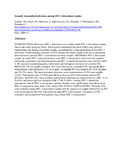| dc.description.abstract | INTRODUCTION:
More new HIV-1 infections occur within stable HIV-1-discordant couples than in any other group in Africa, and sexually transmitted infections (STIs) may increase transmission risk among discordant couples, accounting for a large proportion of new HIV-1 infections. Understanding correlates of STIs among discordant couples will aid in optimizing interventions to prevent HIV-1 transmission in these couples.
METHODS:
HIV-1-discordant couples in which HIV-1-infected partners were HSV-2-seropositive were tested for syphilis, chlamydia, gonorrhea, and trichomoniasis, and HIV-1-uninfected partners were tested for HSV-2. We assessed sociodemographic, behavioral, and biological correlates of a current STI.
RESULTS:
Of 416 couples enrolled, 16% were affected by a treatable STI, and among these both partners were infected in 17% of couples. A treatable STI was found in 46 (11%) females and 30 (7%) males. The most prevalent infections were trichomoniasis (5.9%) and syphilis (2.6%). Participants were 5.9-fold more likely to have an STI if their partner had an STI (P<0.01), and STIs were more common among those reporting any unprotected sex (OR = 2.43; P<0.01) and those with low education (OR = 3.00; P<0.01). Among HIV-1-uninfected participants with an HSV-2-seropositive partner, females were significantly more likely to be HSV-2-seropositive than males (78% versus 50%, P<0.01).
CONCLUSIONS:
Treatable STIs were common among HIV-1-discordant couples and the majority of couples affected by an STI were discordant for the STI, with relatively high HSV-2 discordance. Awareness of STI correlates and treatment of both partners may reduce HIV-1 transmission. | en |

